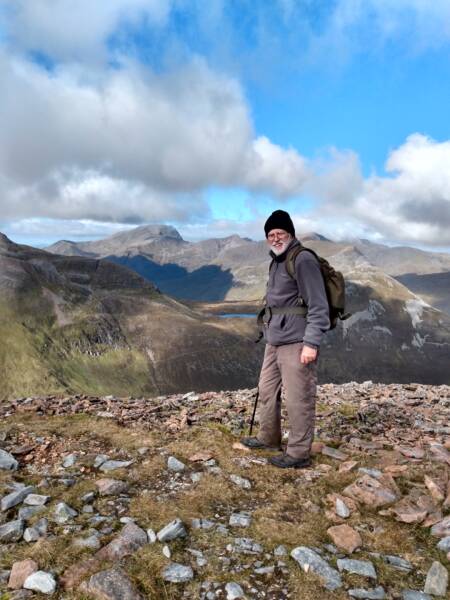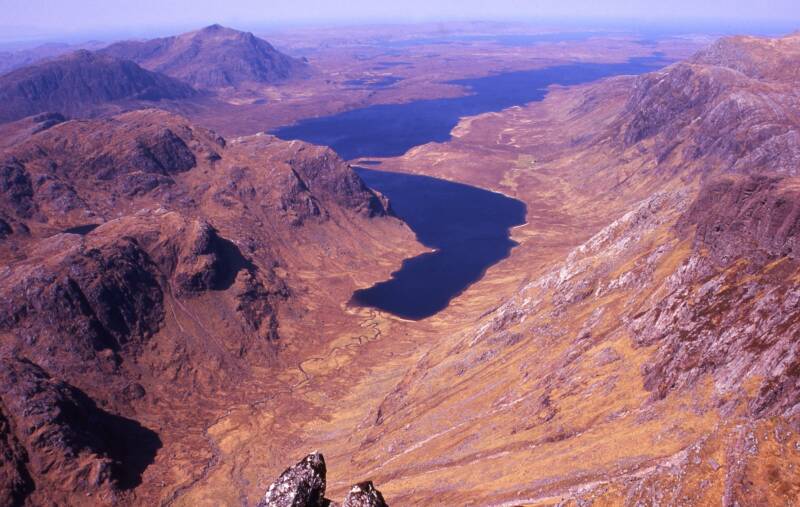As many Walkhighlanders know only too well, Munro-bagging can be a headily addictive pursuit, and it’s one gaining more traction than ever in the era of social distancing. But where did it all begin? In his new book, The Munros: A History, Andrew Dempster traces the sport back to its source in 1891, with many a nod to significant figures – both past and present – along the way. Here’s an extract from the first chapter, which takes a look at the key figures that helped influence the creation of the list.
ON THE LEVEL bealach below the high point of the Beinn a’ Ghlò ridge in Perthshire, the wind shrieks like a banshee as it funnels furiously through the gap in the ridge. A lone figure is crouched over a wooden-shafted alpenstock, steadying himself in the frenzied maelstrom. The abominable cold impels him to persevere upwards, dragging his heavy hobnail boots through deep powder snow to another wind scoured bealach 500 feet above.
The figure then turns to face north-east with the merciless wind now thankfully behind him. The manic, turbulent gusts are now whipping up snow
in spiral columns several hundred feet high, penetrating everything, filling pockets and drifting between waistcoat and shirt, where it melted and then froze into a solid wedge of ice.
Munro, H, ‘Notes on Carn Liath and Beinn Vuroch’ in Scottish Mountaineering Club Journal volume 1, 1891
The wind has partially stripped the final section of summit ridge of snow to reveal lethal, verglassed, angular rocks on which he attempts to gain purchase. Wild eddies of spindrift momentarily conceal maddening pockets of deep snow, into which he clumsily staggers, cursing under his breath.

After what seems like an eternity, his smarting eyes spot a substantial pile of heavily iced rocks, which he aims for like a man possessed. On reaching the cairn, with his back still to the buffeting wind, he lays down his long ice-axe and then removes his woollen mittens, stuffing them under his tweed jacket.
His hands, already cold, reach into a jacket pocket and pull out a round container. Fumbling desperately, he opens the lid, removes a pocket aneroid and proceeds to perform various height measurements, despite the frenzied flapping of his Inverness cape, which he continually pulls round him for extra warmth.
Leaden clouds are now scudding across the sky to reveal acres of blue above sculptured waves of white peaks in all directions. Thankfully, he has already recorded details of the views on a lower summit:
Views good – Cairngorms and Ben Alder groups, the Glencoe hills, Schiehallion (which does not show to advantage from here), Ben Lawers looking well, with Stobinian over his left shoulder, Ben Chonzie, the Fifeshire Lomonds and Sidlaws showing well, with the smoke of Dundee behind. The special feature, however, is the fine view of the higher peaks of Beinn a’ Ghlò.
The highest peak of Beinn a’ Ghlò, on which he now stands, is a freezing and furious cauldron from which he knows he must immediately descend. His hands, now red and numb with cold, struggle to replace the aneroid back in its container and the container back to ice-lined pocket. He forces his Balmoral bonnet more firmly onto his head and briefly touches his beard, now a frozen mass of tiny icicles, as are his moustache and eyebrows. Before replacing his mitts, he pulls a solid ice-caked chunk of tablet from a pocket and forces it into his mouth, slowly releasing its sweetness and energy to his flagging form. Finally, he reaches into an inside pocket for a hip-flask. His fingers are useless, unfeeling appendages, but he manages to unscrew the flask and swig back a mouthful of the amber nectar within.

In seconds he replaces the flask, dons his mitts and grabs his axe to begin the steep descent to Glen Loch. On his journey through deep, drifting snow, he mercifully escapes the worst of the wind, but the relief is short-lived: blood returns to his hands, producing painful hot-aches. Over two hours later he reaches the lonely outpost of Daldhu and the start of the last seven miles through Gleann Fearnach to his nightly destination at the estate house of Dirnanean.
In the fastly fading light of the Scottish winter, he finally reaches shelter, where his hosts
had to scrape me down with a knife to get the frozen snow off me before I could enter the house.
He goes on to remark that ‘in all my winter experience I never suffered so severely from cold’.
During that winter’s day of 22 January 1891, Hugh Munro had completed a 20-mile mountain traverse from Blair Atholl to Dirnanean. An hour later, a thawed out, bathed and freshly dressed Munro sat before a roaring log fire with dram in hand, awaiting dinner. He would certainly deserve it.
Leaving aside the obvious fitness, fortitude and sheer determination of someone tackling the above expedition, which even in summer would be considered a long and challenging route, two observations stand out. Firstly, that the route was attempted in winter, and secondly, that a return to his point of departure at Blair Atholl was declined in favour of a new nightly destination.

Concerning the first point, Munro, a member of the Scottish Mountaineering Club (SMC), had previously intimated in the SMC Journal that he was looking for companions to join him in hill forays during the months of January, February and March, being ‘much engaged’ later in the year. It is also apparent that he relished winter climbing, and his series of articles entitled ‘Winter Ascents’ in early editions of the SMC Journal are proof of his finer appreciation of the Scottish peaks when under a mantle of snow and ice. He acknowledges that
it cannot be denied that some few disadvantages attend winter and early Spring climbing, but I am sure that all who have tried it will agree that the pleasure derived is more than ample compensation.
Munro, H, ‘Winter Ascents’ in Scottish Mountaineering Club Journal volume 1, 1890, pp. 20–24.
I would surmise that such ample compensation would struggle to exert itself on his Beinn a’ Ghlò traverse of 1891!
Concerning the second point, Munro had a passion for long cross-country routes through remote areas, often lasting several days. These were the days before motor transport dictated one’s return to their starting place. Undoubtedly, the advent of the motor-car opened up large areas of the Highlands to the general public, but contrarily became a ‘millstone’ for those wishing to indulge in long through-routes.
After many other such skirmishes in the Scottish hills, in September of that year, Hugh Munro released his famous ‘Tables of Heights over 3,000 feet’, blissfully unaware that in doing so, his very name would soon become synonymous with Scottish mountains over 3,000 feet and that he was destined to become a legendary figure in Scottish Mountaineering.
